Kinetic artist Jesús Rafael Soto is feted with a duet of retrospectives in Paris and New York
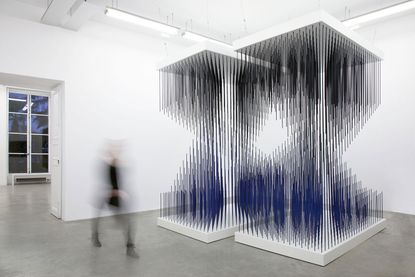
At Emmanuel Perrotin’s Paris gallery, visitors appeared to be lingering around the artworks more than usual. One cannot just stand and stare at Jesús Rafael Soto’s highly technical constructions. 'Pénétrable BBL bleu', a particularly striking example of his work, invites viewers to swish through its baleen-like grid of PVC tubes suspended from a garage-sized metal frame. (And yes, it’s kid friendly.)
The Marais exhibition is the first of two vernissages, both entitled 'Chronochrome', with the second opening in New York tomorrow. Perrotin’s staging of a double Soto retrospective represents a major opportunity to reflect on the artist’s contribution to modern art - specifically the dynamism of his complex and kinetically charged arrangements. The artist, who died in 2005 at the age of 81, added perceptual dimension to his 'paintings' so that wood panels would appear to advance and recede within their frames.
Some pieces, such as 'Cube de Paris' (1990) with its central vortex of red nylon strands, needs a 360-degree perspective; other works, such as the 'Ecriture' series filled with swirling metal reliefs, require shuffling back and forth to experience the vibratory effect. The negative space between the floating prismatic shapes of 'Doble progresión azul y negra' (1975) belies its immense weight (one tonne).
Born in Ciudad Bolivar, Venezuela - where an eponymous museum opened in 1973 - Soto moved to Paris in 1950, which also marked his shift towards a distinctly abstract style that furthered ideas developed by Piet Mondrian, Alexander Calder and Lazló Moholy-Nagy. His first retrospective of kinetic art took place 45 years ago and toured several European institutions including the Stedelijk Museum in Amsterdam and Paris' National Museum of Modern Art.
But historian and curator Matthieu Poirier notes how the artist has not received due recognition—at least, not yet. 'Many people are considering this part of history and Soto is the genius of this history,' says Poirier, who first visited the artist at his Paris studio in 2003. Today, that studio houses the archives and also remains an active workshop for his longtime assistant and fellow Venezuelan artist, René Ugarte, who uses parts that Soto presciently left behind to repair any wear and tear.
To wit, Soto's ouevre simply feels fresh. The 'moiré' pattern created by his optical illusions, for instance, is not unlike watching palm fronds rustle in a breeze. But as Poirier explains, all the tricks are in plain sight: 'He wasn’t James Turrell. Turrell is a magician; he’s hiding all the wires. As far as philosophy, Soto was a materialist — no magic. Everything is explainable.”
Of the nearly 60 exhibited works - in some cases, for sale - several have been made available by the artist’s estate, now represented by Perrotin, while others are loans from international museums. In collaboration with Soto’s four children (his wife passed away last year), Poirier engineered the simultaneous shows as 'a whole with two major parts' which are grouped by 'families of procedures and logics' instead of a more obvious linear chronology. 'With Soto,' he says, 'it is not a linear evolution.'
The fact that Soto’s work resists photography might just be the most remarkable takeaway in the Instagram era. While the precise geometries, the restrained colour palette and delineation of two-dimensional space all register well enough, the planes and illusions vanish and the ensuing flatness renders his art into something altogether different. And apropos of the shows’ title, 'Chronochrome', the longer you engage with each piece, the more it comes to life.
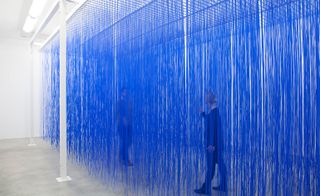
'Pénétrable BBL bleu', 1999, invites viewers to swish through its baleen-like grid of PVC tubes suspended from a garage-sized metal frame.

Galerie Perrotin's staging of a double Soto retrospective represents a major opportunity to reflect on the artist’s contribution to modern art - specifically the dynamism of his complex and kinetically charged arrangements.
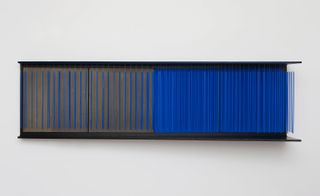
'Untitled, (Mur bleu)', 1966. Born in Venezuela, Soto moved to Paris in 1950, which also marked his shift towards a distinctly abstract style that furthered ideas developed by Piet Mondrian, Alexander Calder and Lazló Moholy-Nagy.

Detail of 'Untitled, (Mur bleu)', 1966.
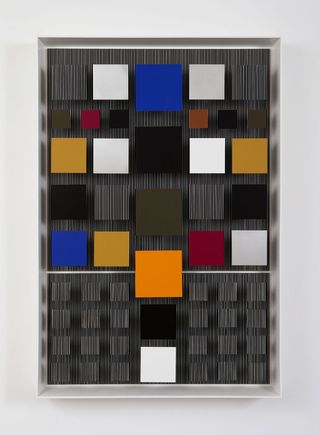
'Untitled (Ambivalencia en el espacio color n°12)', 1981.

'Cuadrados en vibración', 1990.

'Color abajo', 1991.

Detail of 'Color abajo', 1991.
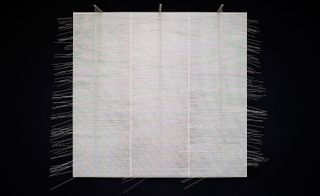
Other works, such as 'Columna rosa', 1973, are filled with swirling metal reliefs, require shuffling back and forth to experience the vibratory effect.

Detail of 'Columna rosa', 1973.

Of the nearly 60 exhibited works - in some cases, for sale - several have been made available by the artist’s estate, now represented by gallerist Emmanuel Perrotin...
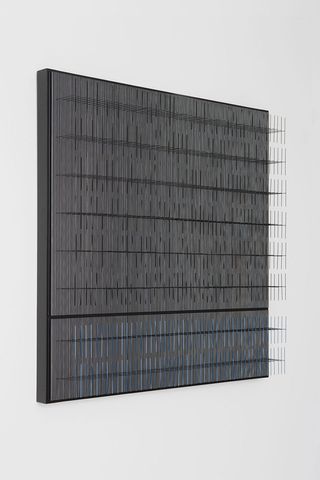
...while others are loans from international museums. Pictured is 'Tes negras y viola', 1994.

Installation view of the Soto retrospective at Galerie Perrotin New York

'Petite progression rose et blanche', 1976.

Soto added perceptual dimension to his 'paintings' so that wood panels would appear to advance and recede within their frames

Installation view of the Soto retrospective at Galerie Perrotin New York
ADDRESS
Galerie Perrotin Paris
76 Rue de Turenne
75003 Paris
France
Wallpaper* Newsletter
Receive our daily digest of inspiration, escapism and design stories from around the world direct to your inbox.
-
 ‘There are hidden things out there, we just need to look’: Studiomama's stone animals have quirky charm
‘There are hidden things out there, we just need to look’: Studiomama's stone animals have quirky charmStudiomama founder's Nina Tolstrup and Jack Mama sieve the sands of Kent hunting down playful animal shaped stones for their latest collection
By Ali Morris Published
-
 Tokyo firm Built By Legends gives fresh life to a performance icon, Nissan’s R34 GT-R
Tokyo firm Built By Legends gives fresh life to a performance icon, Nissan’s R34 GT-RThis Japanese restomod brings upgrades and enhancements to the Nissan R34 GT-R, ensuring the cult of the Skyline stays forever renewed
By Jonathan Bell Published
-
 Squire & Partners' radical restructure: 'There are a lot of different ways up the firm to partnership'
Squire & Partners' radical restructure: 'There are a lot of different ways up the firm to partnership'Squire & Partners announces a radical restructure; we talk to the late founder Michael Squire's son, senior partner Henry Squire, about the practice's new senior leadership group, its next steps and how architecture can move on from 'single leader culture'
By Ellie Stathaki Published
-
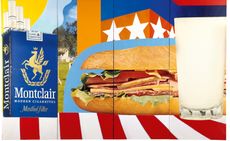 Tom Wesselmann’s enduring influence on pop art goes under the spotlight in Paris
Tom Wesselmann’s enduring influence on pop art goes under the spotlight in Paris‘Pop Forever, Tom Wesselmann &...’ is on view at Fondation Louis Vuitton in Paris until 24 February 2025
By Ann Binlot Published
-
 Miu Miu’s Women’s Tales film series comes to life for Art Basel Paris
Miu Miu’s Women’s Tales film series comes to life for Art Basel ParisIn ‘Tales & Tellers’, interdisciplinary artist Goshka Macuga brings Miu Miu’s Women’s Tales film series for Art Basel Paris to life for the public programme
By Amah-Rose Abrams Published
-
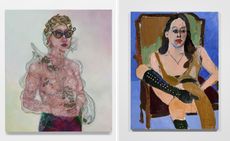 Art Basel returns to Paris: here is everything to see and do
Art Basel returns to Paris: here is everything to see and doArt Basel Paris 2024 (18 - 20 October 2024) returns, opening at the newly renovated Grand Palais
By Amah-Rose Abrams Published
-
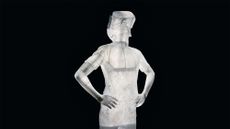 Elmgreen & Dragset explore contemporary masculinity in Paris
Elmgreen & Dragset explore contemporary masculinity in ParisWe visit Elmgreen & Dragset at their Berlin studio ahead of new exhibition ‘L’Addition’ at Paris’ Musée d’Orsay, a subversive take on the classical form
By Hannah Silver Published
-
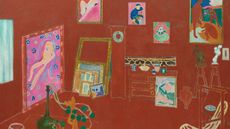 Don’t miss Henri Matisse and Ellsworth Kelly at Fondation Louis Vuitton
Don’t miss Henri Matisse and Ellsworth Kelly at Fondation Louis VuittonFondation Louis Vuitton present a series of works by Matisse and Kelly, celebrating the influence they had on the trajectory of contemporary art
By Tianna Williams Published
-
 ‘Who has not dreamed of seeing what the eye cannot grasp?’: Rencontres d’Arles comes to the south of France
‘Who has not dreamed of seeing what the eye cannot grasp?’: Rencontres d’Arles comes to the south of FranceLes Rencontres d’Arles 2024 presents over 40 exhibitions and nearly 200 artists, and includes the latest iteration of the BMW Art Makers programme
By Sophie Gladstone Published
-
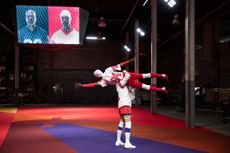 Matthew Barney draws on a sporting horror history with video installation ‘Secondary’
Matthew Barney draws on a sporting horror history with video installation ‘Secondary’Matthew Barney revisits a haunting memory of violence and spectacle in his first institutional show in Paris in over a decade
By Hili Perlson Published
-
 Nicole Eisenman explores the dimensions of sculpture and painting at Hauser & Wirth Paris
Nicole Eisenman explores the dimensions of sculpture and painting at Hauser & Wirth ParisNicole Eisenman presents ‘with, and, of, on Sculpture’, her first retrospective at Hauser & Wirth Paris drawing inspiration from political challengers to ABBA
By Tianna Williams Published